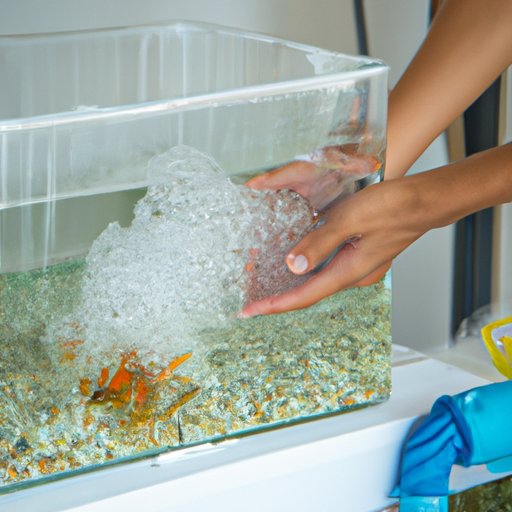
Introduction
Keeping a fish tank is a great way to add beauty and life to any room. However, without proper maintenance, it can quickly become a breeding ground for harmful bacteria, parasites, and algae. That’s why it’s crucial to clean your fish tank regularly to ensure the health and safety of your aquatic pets. In this article, we’ll guide you through the step-by-step process of cleaning your fish tank, provide tips for maintenance, discuss the importance of filter maintenance, help you overcome common issues, and provide advice about the best tools for the job.
Step-by-Step Guide to Cleaning a Fish Tank
The first step is to gather all the required cleaning materials that include a new bucket, an algae scraper, a fishnet, a siphon, an aquarium gravel cleaner, a clean sponge, and clean water. Before draining the tank, ensure that you have the same temperature and water as the previous one.
Start by removing all decorations, plants, and rocks from the aquarium. If there are live plants, remove and put them in a clean plastic bag with some water. Then, using a siphon, drain 25% of the water into the bucket, ensuring to stop the siphon before you reach the gravel. Use the aquarium gravel cleaner to remove any waste in the gravel. Remember never to use any disinfectant to clean your aquarium.
Next, use a clean sponge and water to scrub the glass of the tank properly. You can also use an algae scraper to remove stubborn algae. Re-attach all rocks, decorations, and plants that were removed earlier, ensuring that they are properly positioned and arranged as before. Be careful not to dislodge or damage any live plants. Then, top off the aquarium with fresh water with the same temperature and de-chlorinator before returning the fish.
Tips for Maintenance
Checking the water quality is essential to your fish’s health. Use test strips or liquid tests to ensure that the ammonia, nitrates, and nitrites in the water are safe for your tank. Feed the fish properly to avoid overfeeding, which leads to an increase in the nitrogenous waste build-up that can harm your fish. Cleaning your aquarium 25% every other week or 10% each week ensures that the water is safe and fresh for the fish. Avoid overcrowding and stress on the fish by selecting appropriate tank mates, such as fish of similar breed.
The Importance of Filter Maintenance
Your aquarium filter is crucial for keeping a clean and healthy fish tank. It removes waste, debris, and harmful toxins from the water. The filter also ensures healthy bacteria grow in the aquarium, facilitating the nitrogen cycle, which is essential for your fish’s survival. Neglecting to clean your filter often causes the filter to clog, resulting in poor filtration and circulation and posing a threat to your fish’s health. Be sure to clean the filter monthly by following the manufacturer’s instructions of either replacing or cleaning the part components.
Overcoming Common Issues
An overabundance of algae can cause green water, making your tank unappealing. Avoid leaving your tank in direct sunlight and reduce the amount of light provided. Also, limit the food you offer to your fish and clean your aquarium more regularly. Be extra cautious if you have sensitive plants or fish. Overfeeding your fish leads to an excessive build-up of food particles, causing pollution, bacteria growth, and algae bloom. Reduce the feeding time per day to manage the food build-up.
Avoiding Harmful Chemicals
Cleaning your aquarium using harsh chemicals and cleaning solutions is hazardous to your fish’s health. They can cause skin irritation, lethargy, and even death. Replace the chemicals with natural methods such as vinegar, baking soda, and boiling water, which are safe alternatives to chemicals. Baking soda, for instance, is effective in removing dirt and stains without harming the aquatic life.
Best Tools for the Job
There are several aquarium cleaning tools available, each with its function and advantage. A siphon is ideal for water changes, while an algae scraper is perfect for removing algae from glass or acrylic aquariums. A fishnet helps remove fish from the aquarium during cleaning tasks, and an aquarium gravel cleaner helps remove debris from fish waste, leftover food, and other waste. A Scrubber can be used to clean off the stubborn waste from the ornaments and decorations.
Conclusion
Maintaining a clean and healthy aquarium doesn’t have to be a daunting task if it’s done regularly. Following our step-by-step guide, tips for maintenance, importance of filter maintenance, how to overcome common issues, avoiding harmful chemicals, and identifying the ideal tools for the task ensures your aquarium stays healthy and attractive and your fish remain happy. Remember to get your materials from a reputable pet store and check each product’s suitability to avoid disastrous consequences. If uncertain, seek the services of professionals.





